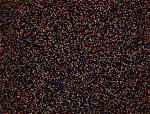
Next-Generation Sequencer
The problem of trying to “read” this string of DNA is that molecules are small. Each nucleotide along the DNA string is spaced about 3x10-10m apart. If each nucleotide were the size of a rice grain, your hand would be nearly the size of the USA! So it is nearly impossible to “look,” even with the highest-powered microscopes, to read the sequence of letters. Scientists have developed many strategies to overcome this problem.
DNA sequencing was invented by Fred Sanger and independently by Walter Gilbert and Allan Maxam in the early 1970s. By the late 1980s, automated sequencing machines were developed; they utilized the basic strategy developed by Fred Sanger but with rapid real-time detection methods. These earliest sequencing machines could read approximately 3,000 letters per day. For the 3 billion letters of the human genome, this means it would have taken about 2,700 years to sequence.
The machines we use today can read 150 billion letters per day! This is a 50 million-times increase in efficiency! We call this new generation of machines next-generation sequencing (NGS) machines.


 Discovering the Genome
Discovering the Genome